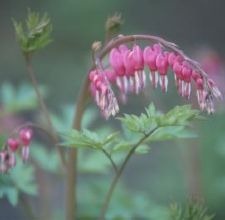Bleeding heart (Dicentra sp.) is a staple of the spring garden. The plant’s delicate fern-like leaves and pendulous lyre-shaped flowers were especially loved by Victorian-era gardeners. Today there are over 20 species of the spring-blooming perennial that bloom in several different colors.
Description
-
Bleeding heart grows up to 3 feet tall with feathery leaves divided into three segments. Flowers grow on thin stems looking like necklace pendants in groups of seven to 15. Blossoms are heart-shaped in shades of pink, white or red.
History
-
Dicentra is native to China and Korea. J. G. Gmelin, a botanist from Germany, brought the plant to Russia in 1740. It traveled to England in 1847 where it became a common garden plant, according to University of Arkansas Extension. Other names for bleeding heart are Dutchman’s breeches, staggerweed and it shares the nickname heart’s ease with the pansy.
Requirements
-
Too much sun tends to make the plant wither and retreat underground. It will naturally do so by midsummer. Plant bleeding heart in shady areas to keep them blooming as long as possible, from mid-spring to the early days of June. The plant requires well-drained, but moist rich soil.
Care
-
Plant transplants or divide and replant existing plants in early spring. Space 18 to 30 inches apart depending on the variety and instructions from the nursery. Amend clay soil with plenty of organic matter before planting to allow roots to grow unimpeded. Cut back foliage as it becomes yellow and cut back blooms when they start to fade. Slugs and snails eat newly emerging shoots in spring, so scatter construction sand or diatomaceous earth on the soil direction around and under the plant to keep them away.
Warning
-
Some people may find that their skin becomes red and itchy when touching the leaves. It does affect allergy sufferers with contact dermatitis. Also, be aware that the plant is somewhat toxic if eaten. Early physicians used it like a narcotic, though a great deal would have to be consumed in order for it to take any effect.
Types
-
Dicentra eximia has fringe-like leaves and small flowers with Alba being a white-flowered cultivar, and Stuart Boothman a pink type. This variety will tolerate some full sun and blooms the longest. D. Formosa does not require as much moisture as other varieties and blooms heavily. Snowflake, Aurora and Alba have white flowers while Adrian’s blooms are red. Luxuriant has cherry-tinged flowers with 12-inch tall blue green leaves. Bacchanal has wine-colored blooms. D. spectabiles is the common type that grows in clumps about 3 feet tall and wide most having 1-inch white or pink flowers. Gold Heart gives an unexpected twist with golden, almost metallic, leaves and rose-colored blooms.


Deprecated: strpos(): Passing null to parameter #1 ($haystack) of type string is deprecated in /home/agriviek8Qv/agriviet.net/public_html/wp-includes/comment-template.php on line 2522